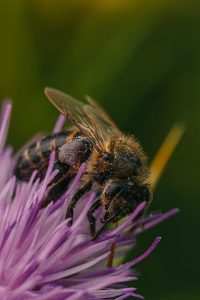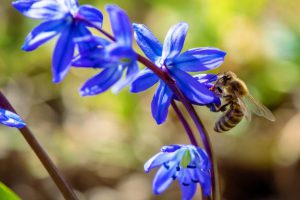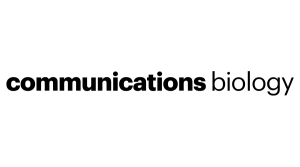By Jay Evans
Love In The Time Of Chasmogasmy: How And When Do Bees Improve Soybean Fields?
As I wrote two months ago, the Intel International Science and Engineering Fair (https://student.societyforscience.org/intel-isef) had plenty of optimistic news for bees and their roles in nature and agriculture. Brooklyn Pardall (Central Lee High School, Iowa) highlighted research she carried out on her family’s 6,000 acre soybean farm, showing significant benefits from the exposure of production soybean plants to honey bees. Soybeans represent a crop where the benefits of insect pollinators are complex and surely underestimated. In theory, soybeans could provide a ubiquitous resource for beekeepers seeking new flowers and profits, assuming growers in fact see an increase in yields when bees (wild or managed) are on the scene. This month I delve into the long history of research on insect pollination and soybean yields. Like a lot of research, this topic sometimes feels like déjà vu all over again, but it is clear that more could be done to advertise soybean cultivars and conditions that benefit from bee pollination and to incentivize beekeepers to take the plunge into a widespread floral source. Given hard evidence, soybean growers might choose cultivars and safe management techniques that reward bees and beekeepers. Soybeans cover 90 million acres in the U.S. (http://usda.mannlib.cornell.edu/usda/current/CropProdSu/CropProdSu-01-12-2018.pdf), so if even a fraction of this landscape joins the pollen-nation that seems like a potentially big deal.
A first stop on any pollination quest, especially for a non-specialist like me, is USDA researcher S.E. McGregor’s ‘Insect Pollination of Cultivated Crop Plants (1976, https://www.ars.usda.gov/ARSUserFiles/20220500/OnlinePollinationHandbook.pdf). McGregor was not big on bee pollination of soybeans to say the least, stating “the soybean is considered to be self-fertile and not benefited by insect pollination” and “there are no recommendations for the use of bees in pollination of soybeans”. Still, he does leave the door open a bit with “although there is no experimental evidence to support them, some soybean growers in Arkansas have indicated that bees increase production of beans, and they encourage the presence of apiaries near their fields.” And my favorite sign of smoke, amidst a discussion of how outcrossing ‘could’ improve yields is “various tests have been conducted to determine the amount of cross-pollination that occurred at different locations, but the agents responsible for the crossing obtained were usually not determined, possibly because the tests were conducted by agronomists who did not consider themselves qualified to record these observations”.
Dr. Eric Erickson apparently ignored his USDA colleague’s pessimism and set off at the same time on a research program to measure the impacts of honey bees on soybean yields. With collaborators including a young Kim Flottum, Dr. Erickson mapped out some of the benefits of bee pollination to soybean yields in the mid-1970s, beginning with “Effects of honey bees on yield of three soybean cultivars” (Crop Science, 1975, https://dl.sciencesocieties.org/publications/cs/abstracts/15/1/CS0150010084). Dr. Erickson provided experimental data from the field to counter the dogma that bees have a minimal impact on soybean yields. As hinted by the title, not all soybean varieties attract bees nor do they all provide good forage for bees. The ‘Hark’ variety was the most chasmogamous (‘open marriage’ for insect pollinators) and indeed plants of this variety showed 7% and 16% yield increases when exposed to bees, in successive years. Two varieties with closed flowers (cleistogamous) showed no benefit from bees and few visitors. Wainer Chiari and colleagues also showed that varieties make the difference, with bees (nearly always honey bees in their study) boosting productivity of Brazilian cultivar BRS-133 by over 50% (Brazilian Archives of Biology and Technology, 2005, http://www.scielo.br/pdf/babt/v48n1/a05v48n1.pdf). Presumably, BRS-133 is a variety that thrives on cross-pollination and its associated influx of genetic diversity. Finally, Diego Blettler and colleagues in Argentina recently showed an 18% yield increase when soybeans were exposed to insects in one year, but no impact for the same soybean cultivar the second year (Apidologie, 2018, https://link.springer.com/article/10.1007/s13592-017-0532-4). The honey bee chauvinist in me says these benefits point to the immense roles of honey bees in crop production, but there is good evidence that other bees are playing significant roles in increasing the soybean crop. Marcelo de O. Milfont and colleagues in Brazil found that native bees alone boosted soybean yields by 6% while honey bees added 18% on top of that (Higher soybean production using honeybee and wild pollinators, a sustainable alternative to pesticides and autopollination, Environmental Chemistry Letters, 2013, https://link.springer.com/article/10.1007/s10311-013-0412-8). Recent work in the U.S. suggests that multiple pollinators can still be found in soybean fields (Defining the insect pollinator community found in Iowa corn and soybean fields: Implications for pollinator conservation, by Matthew O’Neal and colleagues, 2016, Environmental Entomology, https://academic.oup.com/ee/article/45/5/1099/2197225), and these pollinators are likely to enable gene flow in soybeans alongside honey bees.
Despite the observed benefits from these and other studies, growers will not be convinced to welcome bees until there is more clarity on specific cultivars that benefit from pollination and the conditions needed for strong bee-enabled ‘marriages’. Surprisingly given its role as the leading row crop in many countries, there does not seem to be a concerted effort to identify specific soybean varieties that benefit from the gene flow provided by insect pollinators, nor are there steady recommendations for pollinator density in production soybeans.
So what is the big picture for U.S. soybean production, and can the soybean crop be made to be more bee-dependent, and bee-friendly? Nicholas Calderone produced an ambitious summary of the impacts of honey bees and other pollinators on U.S. crop production (“Insect Pollinated Crops, Insect Pollinators and US Agriculture: Trend Analysis of Aggregate Data for the Period 1992–2009” (PlosONe, 2012, https://doi.org/10.1371/journal.pone.0037235), as a follow-up to work by himself and Roger Morse in 2000. Using USDA data, he calculates acreages and productivity for a range of commodities that depend on, or benefit to some extent from, pollinators. Soybeans make this list, albeit with an estimated 10% boost from insect pollination. This 10% is no-doubt an informed choice but it misses the nuances of which varieties are ‘open’ to bees, which planting schemes favor pollination and gene flow, and which soybean management practices are at least somewhat bee friendly. Ten percent of 90 million acres is still substantial, and for 2010 Calderone estimates that bees provide nearly $4 billion in value for soybean growers, arbitrarily split between honey bees and all other pollinators. This surpasses the $2.8B in pollinator benefits for almonds in that year, effectively all from honey bees despite inroads recently from alternate managed or wild pollinators. To be sure, almonds are a high-value crop grown on 1% of the acreage used by soy, but if conditions could be worked out between soybean growers and beekeepers that provide growers substantial benefits and beekeepers some profit and safe forage there seems to be plenty of space for some chasmogasmy. If so, the incentive and insights will come from researchers such as Ms. Pardall who know and care for both sides of this plant-pollinator relationship.
Jay Evans is the Research Leader for the USDA Honey Bee Lab in Beltsville, MD.









